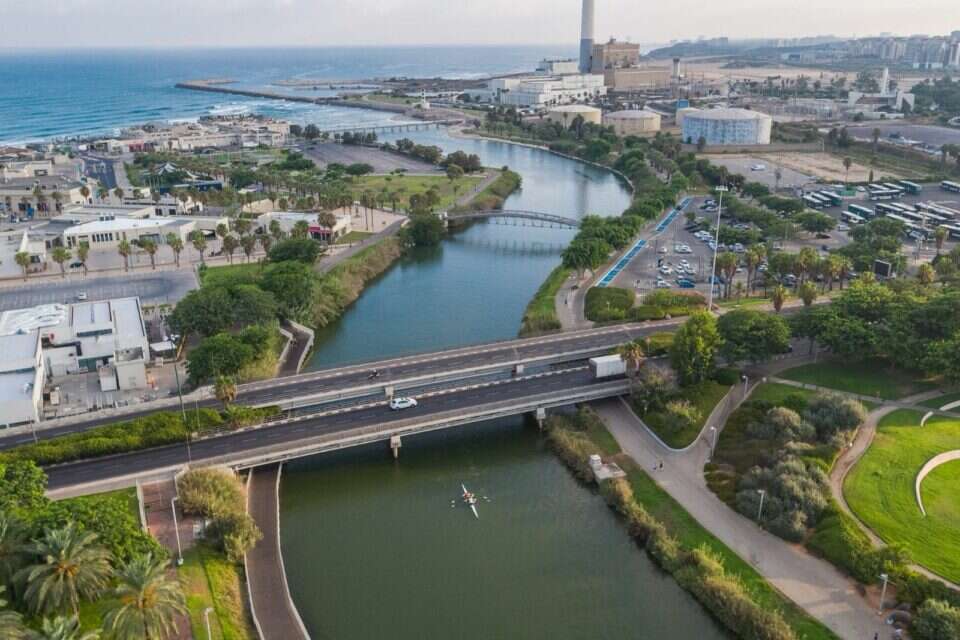The Yarkon River Authority Council approved the "Clean Yarkon" plan, which for the first time includes a system of protections for the river against future infections. In addition, she approved continuing to promote the cessation of the discharge of wastewater (treated sewage) in the river and the discharge of fresh water in its place.
The Yarkon Protection Plan proposes isolating the Yarqon River from the risk of potential contamination, and its implementation will even contribute to mitigation and flooding prevention by creating pooling areas for water suspend and flooding open areas upstream.
The hidden waterfall, the confluence of the Kana River with the Yarkon River following the rains | Yarkon River Authority
Another stage, which is being promoted by the Water Authority together with the Yarkon River Authority, is diverting wastewater from the Yarkon River and discharging fresh water in its place. The Yarkon River Authority has established a steering committee with representatives from the Water Authority, Mekorot, the Ministry of Environmental Protection, the Nature and Parks Authority and planning personnel, and is accompanying the progress of the wastewater removal process. As part of the process, the flow of fresh water from local drillings will be increased from 14-15 mcm (million cubic meters) per year to 22 mcm per year.
The route of the Yarkon River, photo: Yarkon River Authority
Through the plan, the Yarkon River will become a clean, flowing and accessible river. The seven local authorities around it will benefit from the unique natural resource, which constitutes the green lung and the most significant ecological strip along the Gush Dan metropolitan area, the most densely populated metropolis in the country.
Cleaning up the stream is also significant ecological news. Thanks to the extensive activity of the Yarkon River Authority in recent years, fish, mammals and plant species that have disappeared over the years are returning to the river. With the cleaning of the Yarqon River and the prevention of its pollution over time, the ecosystem will continue to develop and enrich along the river's 28 kilometers.
The Yarkon River is currently divided into three segments in terms of water quality: the Upper Yarkon River, which begins at the Yarkon Springs in the Yarkon National Park area, and the Nofar Pool, near Rosh HaAyin, where potable water (drinking water quality) is pumped from Mekorot drillings at a quantity of about 15 million cubic meters per year. The Upper Yarkon, where only fresh water flows, ends in the Hod Hasharon area, at the confluence of the Yarkon streams with the Kana River. From this point, the Middle Yarkon begins where the fresh water is mixed with wastewater (of excellent quality) and flows to the site of seven mills in Tel Aviv.
The route of the Yarkon River - a bird's eye view,
In the Middle Yarkon, which is the main section that passes through the urban area, excellent quality wastewater flows, which means that sailing can be held on the Yarkon, random contact with the water can be made, but the water is dangerous for continuous contact such as bathing, and of course is not fit for drinking.
The Lower Yarkon, or Salty Yarkon, is the section between Seven Mills Dam and the outlet to the sea. In this segment flows a mix of water from the middle segment and sea water.
Today, with the change in the water balance in Israel, increasing the amount of desalination and reducing the water sector's dependence on natural water sources only, a historic opportunity has arisen to return the Yarqon River to its sources.
Huldai, Photo: Coco
Ron Huldai, Mayor of Tel Aviv-Yafo and Chairman of the Yarkon River Authority: "For over two decades we have been working to rehabilitate the Yarkon River. The continuation of the plan to make the river clean, which includes converting wastewater into fresh water and determining protections against future pollution, is a historic opportunity to promote and preserve the river's water, and even improve its quality, thus continuing to turn the Yarqon River into a place of quality of life, community and environment, and in the not too distant future even a place to bathe along its entire length."
Wrong? We'll fix it! If you find a mistake in the article, please share with us

